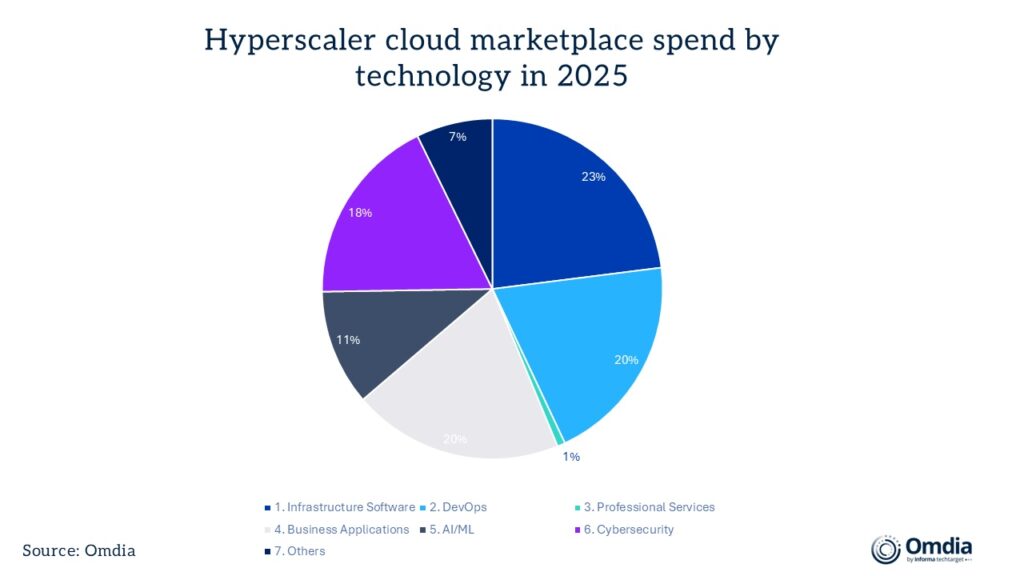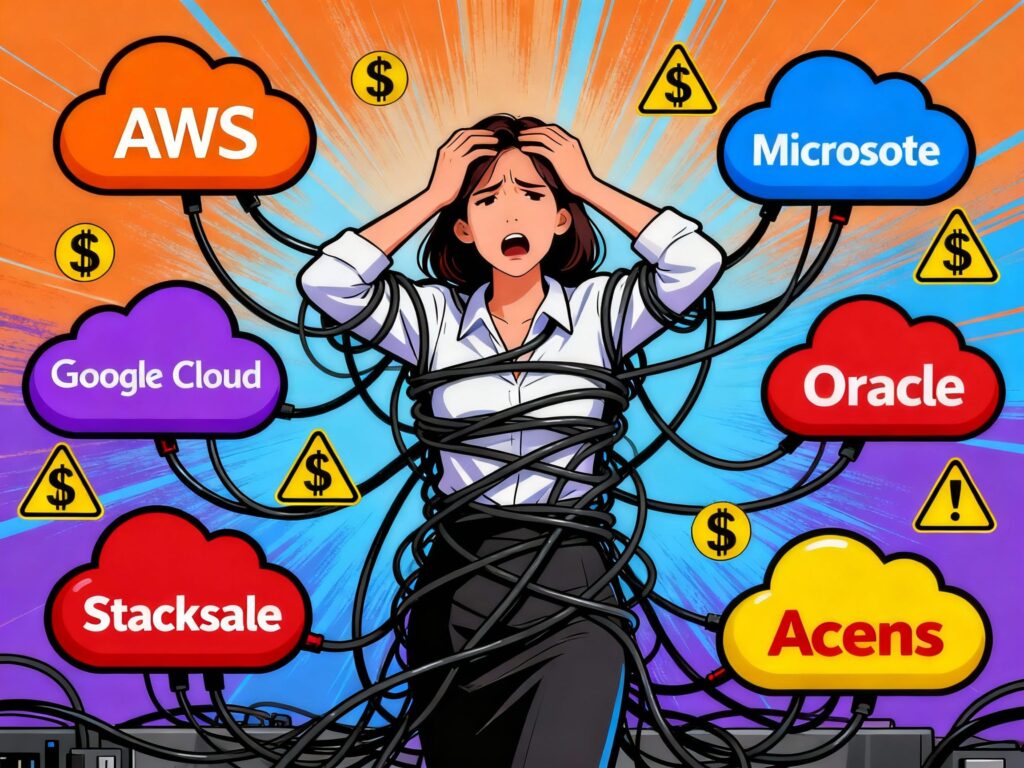The way companies purchase software is rapidly changing, and hyperscaler marketplaces—AWS, Microsoft Azure, and Google Cloud—have become a key channel. According to the Enterprise LEO Forecast 2025-30 report by Omdia (cloud marketplace edition), enterprise software sales through these digital catalogs are projected to grow from $30 billion in 2024 to $163 billion in 2030, representing a CAGR of 29.1% between 2025 and 2030. Beyond the figures, the firm describes a structural shift: the multi-year cloud commitments are becoming the driving force behind marketplace purchases, and agentic AI is emerging as one of the categories with the most traction.
From “burning commitments” to strategic buying
Until recently, many companies took opportunistic advantage of marketplaces to “burn” cloud consumption commitments they could not fully execute. Omdia identifies a tipping point: companies are now negotiating multi-year contracts with hyperscalers reserving explicit allocations for marketplace purchases aligned with their cloud adoption roadmaps. Context helps: Omdia estimates that there are approximately $470 billion in active cloud commitments among AWS, Azure, and Google Cloud—almost $30 billion added just in Q2 2025—and a significant portion of that volume can be consumed through third-party purchases in marketplace.
The result is a cultural shift: purchasing no longer remains purely transactional but becomes a planning mechanism that accelerates deployments, reduces friction, and improves spend governance. The marketplace is becoming a first-line channel, not a “last resort.”
Partners don’t disappear—they facilitate nearly 60% of transactions
One of the most notable findings contradicts the idea that marketplaces “disintermediate” the channel. They don’t disappear—they transform. Omdia projects that by 2030, partners will enable about 60% of marketplace transactions, leveraging Private Offers and distribution models that the three major hyperscalers have refined over recent years. In practice, the partner orchestrates the full cycle: manages client commitments, purchases across multiple marketplaces, packages services, and provides support and adoption.

Furthermore, in the agentic era, partners are creating their own AI offerings (platforms, accelerators, vertical copilots), which allows them to capture an increasing share of the volume circulating through the marketplaces. The value is now not just in reselling licenses but in industrializing the use of AI on the existing cloud fabric.
What is purchased today (and what will grow tomorrow)
Omdia highlights three main categories that together account for 63% of spending on marketplaces:
- Infrastructure software: $10.5 billion
- DevOps: $9.1 billion
- Business applications: $9.1 billion
These constitute the foundations of the client environment: from network and security to observability, deployment automation, or natively cloud-connected ERP/CRM.
Looking ahead, two areas stand out:
- AI (focused on agentic AI): Omdia projects a total spend of $24.4 billion driven by a CAGR of 37%. The firm attributes this surge to microtransactions and the maturation of multi-agent protocols, which pave the way for business models where agents consume and chain services automatically.
- Cybersecurity: will reach $31 billion by 2030 with a CAGR of 31%, bolstered by the consolidation of integrated platforms and the pressure for compliance and data sovereignty.
Why marketplaces will thrive in the “agentic age”
Agentic AI—systems that reason, plan, and act autonomously, invoking tools and APIs—naturally aligns with the marketplace model:
- Living catalog: agents that discover and combine services (APIs, models, connectors) directly from the marketplace.
- Granular monetization: microtransactions and pay-per-use models that align cost with the incremental value of each task.
- Simplified procurement: Private Offers and multi-year plans to scale from pilot to production without renegotiating each component.
As Alastair Edwards, Chief Analyst at Omdia, summarizes, an increasing number of ISVs already reach or surpass $1 billion in annual sales through AWS Marketplace, Azure Marketplace, and Google Cloud Marketplace, activating partners and distributors to reach more cloud customers. In his view, marketplaces are competing to become the preferred channel for agentic AI, as it will represent a growing portion of cloud consumption.
Implications for clients, ISVs, and manufacturers
For enterprise clients, the immediate operational benefit is:
- Less legal and financial friction: standardized contracting, consumption against a pre-signed contract.
- Reduced time-to-value: deployment and governance integrated with account services (identity, billing, observability).
- Spend optimization: a single dashboard for commitments, consumption, and savings (reserved instances, Savings Plans, etc.).
For ISVs, the opportunity is twofold:
- Access to the cloud commitments pool of the client.
- Co-go-to-market with the hyperscaler: Private Offers, MDF funds, priority listings, and joint campaigns.
However, there are obligations: license optimization with cloud consumption, measuring adoption with real telemetry, and aligning pricing and support with the SLA demands of enterprise accounts. The marketplace rewards clarity: plans, levels, metrics, and update policies.
For infrastructure and platform manufacturers, the challenge is to productize their offerings in the marketplace language: consumable packaging, metrics that speak to the client’s FinOps, and ecosystem compatibility (identity, logging, billing, tagging, etc.). Differentiation moves toward purchase experience and operations as much as towards functionality.
Risks and challenges to address
Not all winds are favorable. Omdia and the market highlight three friction points:
- Sovereignty and compliance: regulated sectors demand traceability of data, residency, and controls, which some listings still do not document with sufficient granularity.
- Soft lock-in: buying “where the commitments lie” creates inertia. Mitigation includes data portability, API standards, and multicloud policies.
- Spend governance: without rigorous FinOps, the ease of purchase can lead to a loss of control. Recommendations include roles, budgets, and alerts by business unit.
By 2030: five winning moves
- Negotiate cloud contracts with “marketplace pockets”: reserve a percentage from the start for third-party purchases and Private Offers.
- Orchestrate partners: leverage their ability to optimize commitments, craft private offers, and pilot complex deployments.
- Standardize IaC and security: reusable modules (Terraform, Bicep, Deployment Manager) and controls (CIS, NIST) to industrialize production deployment.
- Measure value, not just cost: connect consumption to business KPIs (sales, fraud prevention, lead time, SLOs), especially in agentic AI.
- Build realistic multicloud strategies: select 2-3 clouds based on capabilities (data, AI, security), not trends; move repetitive workloads and federate data.
Frequently Asked Questions
What are hyperscaler marketplaces, and why are they growing so quickly?
They are software storefronts integrated into AWS, Azure, and Google Cloud, enabling purchase and deployment of third-party solutions against existing cloud commitments. They grow through multi-year contracts with “marketplace pockets,” lower purchase friction, and the rise of agentic AI with variable consumption.
Do they disintermediate partners?
Not really. According to Omdia, by 2030, partners will facilitate approximately 60% of the transactions, from Private Offers to multi-cloud commitment management and adoption services. The partner value shifts from reselling to orchestration and specialization (including AI).
Which categories lead spending, and which will grow fastest?
Leading are Infrastructure ($10.5 billion), DevOps ($9.1 billion), and Business applications ($9.1 billion). Growth areas include AI ($24.4 billion with 37% CAGR) and Cybersecurity ($31 billion with 31% CAGR) towards 2030.
How should companies prepare to buy on marketplaces without surprises?
Define FinOps policies, reserve budget in cloud contracts, leverage Private Offers, demand SLA and compliance documentation, and automate deployments with IaC and security controls from day one.
Source: Omdia— “Hyperscaler cloud marketplace sales to hit $163 billion by 2030” (October 6, 2025).

